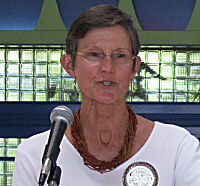
"There’s an increase in the amount of dust out of Africa," she told 20 members of the Rotary Club of St. John at their weekly luncheon meeting at the Westin Resort and Villas.
According to Garrison, "hundreds of millions of tons" on dust lift off African deserts. Most of it blows across the Atlantic Ocean to the Caribbean and the Americas.
Many Africans use pesticides such as DDT to combat malaria and the desert locusts that eat crops, Garrison said. And they get rid of old tires and plastic bags by burning them.
"These things are very toxic," Garrison said. Those toxins are strongest when the dust comes off Africa on its way across the Atlantic Ocean, but some remain when they reach the region, she said.
Most people don’t suffer severe problems when the territory is blanketed in Sahara dust, but the dust exacerbates heart and lung problems, Garrison said.
Garrison also pointed out that the Sahara dust that blows here picks up airborne matter as it travels across the Virgin Islands. The dust heads north to the United States, where it picks up more debris. From there, it heads across the Atlantic Ocean to Europe for another infusion of matter. The dust-laden air then continues its cycle around the world.
"Everything you do is spread throughout the world," Garrison said.
Garrison, who has long worked with the territory’s corals, began studying Saharan dust in 2000. She and her husband, John Garrison, first sailed into the territory in the 1983. She worked for V.I. National Park before joining the St. John office of the USGS in the early 1990s. She transferred to St. Petersburg in 2001.
According to Garrison, the Virgin Islands has lost 50 percent of its corals over the past 30 years.





